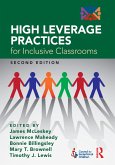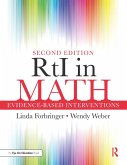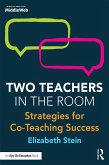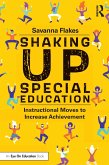High Leverage Practices for Inclusive Classrooms (eBook, ePUB)
Redaktion: McLeskey, James; Lewis, Timothy J.; Brownell, Mary T.; Billingsley, Bonnie; Maheady, Lawrence
30,95 €
30,95 €
inkl. MwSt.
Sofort per Download lieferbar

15 °P sammeln
30,95 €
Als Download kaufen

30,95 €
inkl. MwSt.
Sofort per Download lieferbar

15 °P sammeln
Jetzt verschenken
Alle Infos zum eBook verschenken
30,95 €
inkl. MwSt.
Sofort per Download lieferbar
Alle Infos zum eBook verschenken

15 °P sammeln
High Leverage Practices for Inclusive Classrooms (eBook, ePUB)
Redaktion: McLeskey, James; Lewis, Timothy J.; Brownell, Mary T.; Billingsley, Bonnie; Maheady, Lawrence
- Format: ePub
- Merkliste
- Auf die Merkliste
- Bewerten Bewerten
- Teilen
- Produkt teilen
- Produkterinnerung
- Produkterinnerung

Bitte loggen Sie sich zunächst in Ihr Kundenkonto ein oder registrieren Sie sich bei
bücher.de, um das eBook-Abo tolino select nutzen zu können.
Hier können Sie sich einloggen
Hier können Sie sich einloggen
Sie sind bereits eingeloggt. Klicken Sie auf 2. tolino select Abo, um fortzufahren.

Bitte loggen Sie sich zunächst in Ihr Kundenkonto ein oder registrieren Sie sich bei bücher.de, um das eBook-Abo tolino select nutzen zu können.
High Leverage Practices for Inclusive Classrooms, Second Edition offers a set of practices that are integral to the support of student learning, and that can be systematically taught, learned, and implemented by those entering the teaching profession.
- Geräte: eReader
- ohne Kopierschutz
- eBook Hilfe
- Größe: 7.21MB
Andere Kunden interessierten sich auch für
![High Leverage Practices for Inclusive Classrooms (eBook, PDF) High Leverage Practices for Inclusive Classrooms (eBook, PDF)]() High Leverage Practices for Inclusive Classrooms (eBook, PDF)30,95 €
High Leverage Practices for Inclusive Classrooms (eBook, PDF)30,95 €![RtI in Math (eBook, ePUB) RtI in Math (eBook, ePUB)]() Linda ForbringerRtI in Math (eBook, ePUB)31,95 €
Linda ForbringerRtI in Math (eBook, ePUB)31,95 €![Two Teachers in the Room (eBook, ePUB) Two Teachers in the Room (eBook, ePUB)]() Elizabeth SteinTwo Teachers in the Room (eBook, ePUB)30,95 €
Elizabeth SteinTwo Teachers in the Room (eBook, ePUB)30,95 €![Shaking Up Special Education (eBook, ePUB) Shaking Up Special Education (eBook, ePUB)]() Savanna FlakesShaking Up Special Education (eBook, ePUB)26,95 €
Savanna FlakesShaking Up Special Education (eBook, ePUB)26,95 €![Rigor for Students with Special Needs (eBook, ePUB) Rigor for Students with Special Needs (eBook, ePUB)]() Barbara R. BlackburnRigor for Students with Special Needs (eBook, ePUB)30,95 €
Barbara R. BlackburnRigor for Students with Special Needs (eBook, ePUB)30,95 €![Designing Effective Math Interventions (eBook, ePUB) Designing Effective Math Interventions (eBook, ePUB)]() Jessica HuntDesigning Effective Math Interventions (eBook, ePUB)30,95 €
Jessica HuntDesigning Effective Math Interventions (eBook, ePUB)30,95 €![Remote Learning Strategies for Students with IEPs (eBook, ePUB) Remote Learning Strategies for Students with IEPs (eBook, ePUB)]() Kathryn WelbyRemote Learning Strategies for Students with IEPs (eBook, ePUB)30,95 €
Kathryn WelbyRemote Learning Strategies for Students with IEPs (eBook, ePUB)30,95 €-
-
-
High Leverage Practices for Inclusive Classrooms, Second Edition offers a set of practices that are integral to the support of student learning, and that can be systematically taught, learned, and implemented by those entering the teaching profession.
Dieser Download kann aus rechtlichen Gründen nur mit Rechnungsadresse in A, B, BG, CY, CZ, D, DK, EW, E, FIN, F, GR, HR, H, IRL, I, LT, L, LR, M, NL, PL, P, R, S, SLO, SK ausgeliefert werden.
Produktdetails
- Produktdetails
- Verlag: Taylor & Francis eBooks
- Seitenzahl: 382
- Erscheinungstermin: 30. März 2022
- Englisch
- ISBN-13: 9781000555578
- Artikelnr.: 63553220
- Verlag: Taylor & Francis eBooks
- Seitenzahl: 382
- Erscheinungstermin: 30. März 2022
- Englisch
- ISBN-13: 9781000555578
- Artikelnr.: 63553220
- Herstellerkennzeichnung Die Herstellerinformationen sind derzeit nicht verfügbar.
James McLeskey is Professor in the School of Special Education, School Psychology, and Early Childhood Studies at the University of Florida, and project staff member for the CEEDAR Center. Lawrence Maheady is Professor and Horace Mann Endowed Chair in the Exceptional Education Department at SUNY Buffalo State. Bonnie Billingsley is Professor of Teaching and Learning at Virginia Tech. She teaches in both the teacher preparation and doctoral programs at Virginia Tech. Mary T. Brownell is a Distinguished Professor of Special Education at the University of Florida and Director of the Collaboration for Effective Educator Development, Accountability and Reform (CEEDAR) Center. Timothy J. Lewis is Curators' Distinguished Professor of Special Education, Director of the University of Missouri Center for School-wide Positive Behavior Support, and Co-director of the Center on Positive Behavioural Interventions and Supports (PBIS).
Section 1: Collaboration High Leverage Practices 1. Collaborating with Colleagues to Increase Student Success 2. Lead Effective Meetings with Professionals and Families 3. Collaborate with Families to Support Student Learning and Secure Needed Services Section 2: Assessment High Leverage Practices 4. Using Multiple Sources of Information to Develop a Comprehensive Understanding of a Student's Strengths and Needs 5. Interpreting and Communicating Assessment Information with Stakeholders to Collaboratively Design and Implement Educational Programs 6. Using Student Assessment Data, Analyzing Instructional Practices, and Making Necessary Adjustments that Improve Student Outcomes Section 3: Social/Emotional/Behavioral High Leverage Practices 7. Consistent, Organized, Respectful Learning Environment 8. Using Feedback to Improve Student Outcomes 9. Teaching Social Skills 10. Conducting Functional Behavior Assessments to Develop Individualized Behavior Support Plans Section 4: Instruction High Leverage Practices 11. Identify and Prioritize Long- and Short-term Learning Goals 12. Systematically Design Instruction Toward a Specific Goal 13. Adapt Curriculum Tasks and Materials for Specific Learning Goals 14.Teaching Cognitive and Metacognitive Strategies to Support Learning and Independence 15. Providing Scaffolded Supports 16. Use Explicit Instruction 17. Using Flexible Grouping 18. Use Strategies to Promote Active Student Engagement 19. Using Assistive and Instructional Technologies 20. Provide Intensive Instruction 21.Teach Students to Maintain and Generalize New Learning Across Time and Settings 22. Providing Positive and Corrective Feedback 23. Reflections on High Leverage Practices for Teachers, School Leaders, and Teacher Educators
Section 1: Collaboration High Leverage Practices 1. Collaborating with Colleagues to Increase Student Success 2. Lead Effective Meetings with Professionals and Families 3. Collaborate with Families to Support Student Learning and Secure Needed Services Section 2: Assessment High Leverage Practices 4. Using Multiple Sources of Information to Develop a Comprehensive Understanding of a Student's Strengths and Needs 5. Interpreting and Communicating Assessment Information with Stakeholders to Collaboratively Design and Implement Educational Programs 6. Using Student Assessment Data, Analyzing Instructional Practices, and Making Necessary Adjustments that Improve Student Outcomes Section 3: Social/Emotional/Behavioral High Leverage Practices 7. Consistent, Organized, Respectful Learning Environment 8. Using Feedback to Improve Student Outcomes 9. Teaching Social Skills 10. Conducting Functional Behavior Assessments to Develop Individualized Behavior Support Plans Section 4: Instruction High Leverage Practices 11. Identify and Prioritize Long- and Short-term Learning Goals 12. Systematically Design Instruction Toward a Specific Goal 13. Adapt Curriculum Tasks and Materials for Specific Learning Goals 14.Teaching Cognitive and Metacognitive Strategies to Support Learning and Independence 15. Providing Scaffolded Supports 16. Use Explicit Instruction 17. Using Flexible Grouping 18. Use Strategies to Promote Active Student Engagement 19. Using Assistive and Instructional Technologies 20. Provide Intensive Instruction 21.Teach Students to Maintain and Generalize New Learning Across Time and Settings 22. Providing Positive and Corrective Feedback 23. Reflections on High Leverage Practices for Teachers, School Leaders, and Teacher Educators







